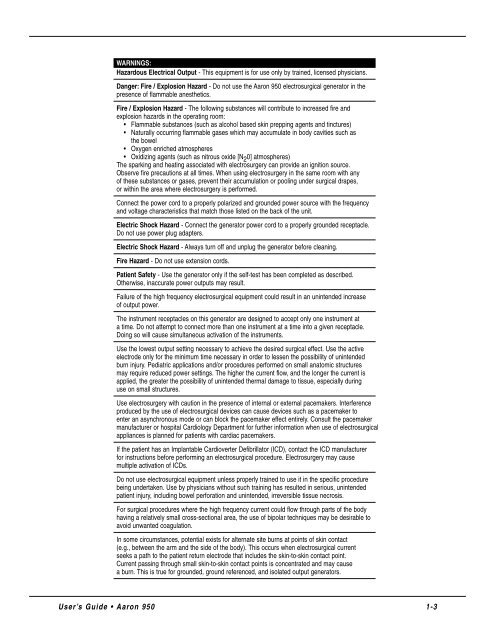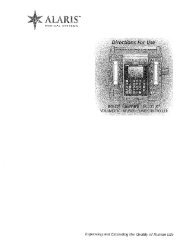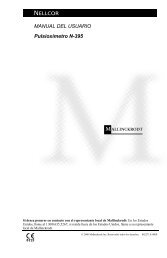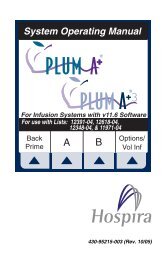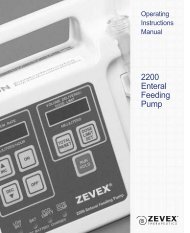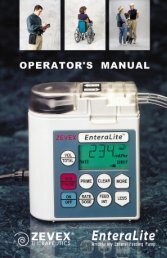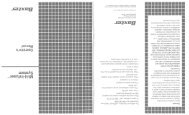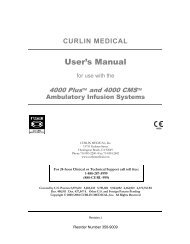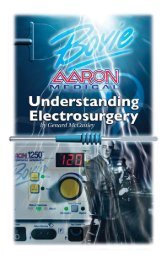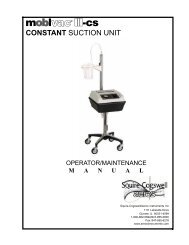Aaron Bovie 950 User Manual - Med-E-Quip Locators
Aaron Bovie 950 User Manual - Med-E-Quip Locators
Aaron Bovie 950 User Manual - Med-E-Quip Locators
- No tags were found...
You also want an ePaper? Increase the reach of your titles
YUMPU automatically turns print PDFs into web optimized ePapers that Google loves.
WARNINGS:Hazardous Electrical Output - This equipment is for use only by trained, licensed physicians.Danger: Fire / Explosion Hazard - Do not use the <strong>Aaron</strong> <strong>950</strong> electrosurgical generator in thepresence of flammable anesthetics.Fire / Explosion Hazard - The following substances will contribute to increased fire andexplosion hazards in the operating room:• Flammable substances (such as alcohol based skin prepping agents and tinctures)• Naturally occurring flammable gases which may accumulate in body cavities such asthe bowel• Oxygen enriched atmospheres• Oxidizing agents (such as nitrous oxide [N 2 0] atmospheres)The sparking and heating associated with electrosurgery can provide an ignition source.Observe fire precautions at all times. When using electrosurgery in the same room with anyof these substances or gases, prevent their accumulation or pooling under surgical drapes,or within the area where electrosurgery is performed.Connect the power cord to a properly polarized and grounded power source with the frequencyand voltage characteristics that match those listed on the back of the unit.Electric Shock Hazard - Connect the generator power cord to a properly grounded receptacle.Do not use power plug adapters.Electric Shock Hazard - Always turn off and unplug the generator before cleaning.Fire Hazard - Do not use extension cords.Patient Safety - Use the generator only if the self-test has been completed as described.Otherwise, inaccurate power outputs may result.Failure of the high frequency electrosurgical equipment could result in an unintended increaseof output power.The instrument receptacles on this generator are designed to accept only one instrument ata time. Do not attempt to connect more than one instrument at a time into a given receptacle.Doing so will cause simultaneous activation of the instruments.Use the lowest output setting necessary to achieve the desired surgical effect. Use the activeelectrode only for the minimum time necessary in order to lessen the possibility of unintendedburn injury. Pediatric applications and/or procedures performed on small anatomic structuresmay require reduced power settings. The higher the current flow, and the longer the current isapplied, the greater the possibility of unintended thermal damage to tissue, especially duringuse on small structures.Use electrosurgery with caution in the presence of internal or external pacemakers. Interferenceproduced by the use of electrosurgical devices can cause devices such as a pacemaker toenter an asynchronous mode or can block the pacemaker effect entirely. Consult the pacemakermanufacturer or hospital Cardiology Department for further information when use of electrosurgicalappliances is planned for patients with cardiac pacemakers.If the patient has an Implantable Cardioverter Defibrillator (ICD), contact the ICD manufacturerfor instructions before performing an electrosurgical procedure. Electrosurgery may causemultiple activation of ICDs.Do not use electrosurgical equipment unless properly trained to use it in the specific procedurebeing undertaken. Use by physicians without such training has resulted in serious, unintendedpatient injury, including bowel perforation and unintended, irreversible tissue necrosis.For surgical procedures where the high frequency current could flow through parts of the bodyhaving a relatively small cross-sectional area, the use of bipolar techniques may be desirable toavoid unwanted coagulation.In some circumstances, potential exists for alternate site burns at points of skin contact(e.g., between the arm and the side of the body). This occurs when electrosurgical currentseeks a path to the patient return electrode that includes the skin-to-skin contact point.Current passing through small skin-to-skin contact points is concentrated and may causea burn. This is true for grounded, ground referenced, and isolated output generators.<strong>User</strong>’s Guide • <strong>Aaron</strong> <strong>950</strong>1-3


